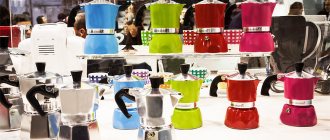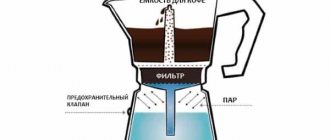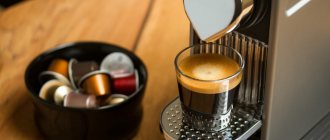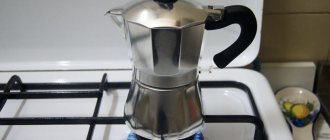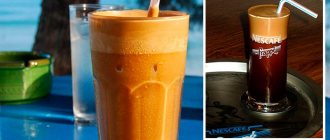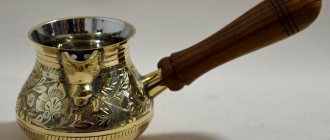What is a geyser coffee maker?
There are as many different ways to make coffee as there are fans of it. You can cook using either natural gas or hot sand, manually or automate the process. The variety and functionality of such devices is amazing. One of the ancient methods is coffee in a geyser coffee maker.
Geyser coffee maker (moka) is a type of coffee maker in which hot water, displaced by steam pressure, rises from the lower reservoir to the upper through the compartment with ground coffee.
The coffee maker can be electric or classic for heating on the stove.
The invention of the Italian Alfonso Bialetti has been decorating kitchens all over the world for more than 80 years with its traditional faceted design.
The body material is predominantly stainless steel and aluminum. Together they define the main characteristics of the utensil:
- hygiene;
- thermal conductivity;
- ease of care.
For those who cannot imagine waking up without an invigorating cup in the morning, at an important business meeting or with friends, it means a little more than just a drink.
The ceremony of its creation begins with the preparation of water. It must be filtered and free of impurities, as they directly affect the taste.
How to choose a geyser Turk
Geyser-type coffee makers are distinguished by the material used and the volume of the drink prepared. The most common coffee makers are made of aluminum and steel.
Case material. Aluminum ones heat up and cool down faster, but are more susceptible to mechanical deformation and oxidation; steel ones are more reliable, but cooling down after use takes much longer.
Handle material. It should be taken into account that when cooking over an open fire, the body of the coffee maker will become covered with soot, and if the handle of the coffee pot is made of polymer or rubber, then with a strong open fire it can melt. You should pay attention to this when choosing a coffee maker - bakelite handles are considered the best.
Coffee pot material. There are models with a transparent coffee pot made of heat-resistant glass or plastic, where the coffee making process can be observed in all its glory.
The volume can vary from 60 ml, which corresponds to a standard cup of espresso, to 600 ml or more, depending on your needs. The appearance and design can be very diverse; coffee makers of various shapes and colors are available on the market, which does not in any way affect their consumer properties.
Recently, electric geyser coffee makers that operate from a household outlet have begun to appear on the market. The principle of operation in them is the same, however, many of them provide functions for adjusting the strength of coffee and automatically turning off after preparing the drink, which is very convenient.
How does a geyser coffee maker work?
Anyone who doesn’t yet know how to brew coffee in a geyser coffee maker will appreciate the simple principle of its operation. The entire structure consists of three main parts: two vessels separated by a container equipped with a filter strainer.
The engine of the entire process is water vapor pressure. It is formed from boiling water in the lower section. Its increasing concentration puts pressure on the liquid. Rising to the top like a geyser, it passes through grinding and a filter to emerge at the top as a ready-to-drink drink.
Coffee metamorphoses behind glass
Some coffee drinkers brew their coffee in a French press. Despite the name, the Italians were the first to receive a patent for such a coffee maker in the 20s of the last century.
A French press is a glass flask with a metal piston inside. Glass is attractive because it does not affect the taste of coffee. In addition, it allows you to observe how the color of the drink changes during preparation.
The Vitesse Zita French press is endowed with all these qualities. The flask is made of heat-resistant glass, and the piston is made of stainless steel. To make pouring coffee convenient, the curved handle has an anti-slip rubber insert. The coffee maker also comes with a measuring spoon, so you don’t have to check the correct proportions every time.
Another interesting model is the VitesseThor French press. It has two important advantages. The comfortable bakelite handle does not heat up at all during brewing, so you won’t get burned when pouring the drink into cups. And thanks to the thermally insulating cork stand, the surface on which you place the coffee maker with a hot drink will not suffer at all.
How to make coffee in a French press? First you need to bring the water to a boil and let it sit for 30 seconds. The brewing temperature should not exceed 90–95 °C. For this method, it is recommended to choose coarsely ground grains. For 500 ml of water we will need 30–35 g of freshly ground grains.
Pour ground coffee into a glass flask, add approximately 250–350 ml of hot water, wait a minute and stir vigorously. Then pour in the remaining hot water and wait another 3 minutes. Now cover the flask with a lid and smoothly lower the piston all the way. An important subtlety is that the finished drink must be immediately poured into another container to stop the extraction. This is the name given to the process of saturating water with the aroma and taste of ground grains. Experts assure: to obtain the desired degree of saturation, extraction should not exceed 19–20%.
How to brew coffee in a geyser coffee maker?
The algorithm of actions is as follows:
- Pour water into the lower part strictly up to the mark.
- We install a funnel with a filter on it.
- Pour in ground coffee.
- Place a bowl on top to collect the prepared coffee.
- We check the tightness of all connections.
Having combined all the components together, tightly connecting them to each other, you can set the coffee maker to warm up. A gas or electric stove can be used for this. If the design allows, you can place it on a special heating base. To obtain the desired taste and aroma, none of this matters. However, there are some subtleties here too.
Useful tips
In order for the moka to last a long time and the taste of coffee to please you, you should follow a few simple rules:
- Do not clean the inside of the coffee maker with cleaning gels: coffee oil on the walls prevents the appearance of a metallic taste in the drink.
- Before using it for the first time, boil water several times in your new coffee maker, or better yet, brew 1 or 2 servings of coffee and then pour them into the sink (this will reduce the metallic taste of the drink).
- Do not leave the moka dirty for a long time: the dried grounds will deteriorate the quality of the device, which will make subsequent servings less tasty.
- Use filtered or bottled water.
- Take high-quality coarse or medium-ground beans (grind them yourself immediately before preparing the drink).
- Do not compact the coffee in the filter, otherwise the water and steam will not pass through it. Leave a small space between the powder and the base of the coffee cup.
- Add cinnamon, chocolate and other ingredients to the finished drink: they can clog the filter and prevent water from passing through it.
- Don't shake the coffee pot while you're doing this, as you may get burned by the fumes.
With the help of a geyser coffee maker, you get delicious aromatic coffee, spending a minimum of effort and money on preparing the drink. The main thing is to follow the cooking recipe and use the device correctly.
Some important tips
How to brew coffee in a geyser coffee maker correctly - you ask. There is nothing complicated, just keep in mind some tricks:
- The coffee grind should be medium. If the grind is coarse, the water will pass to the top very easily and will not brew. If it’s small, the water may not pass through at all.
- It is better to use hot water immediately.
- Monitor the temperature constantly. If you are using a gas stove, then turn the heat to minimum.
- Remove from the heat not when the coffee pot is already making strange noises, but when the coffee just begins to flow into the upper bowl. Unfortunately, this point can only be determined experimentally.
- Don't worry if there is some liquid left in the container after cooking. This phenomenon is normal.
Now you know how to brew coffee in a geyser coffee maker. Share a tart and hot drink with Vkus Company. We sell coffee whose grinding is ideal for preparation in a geyser coffee maker.
Advantages and disadvantages
The negative aspects of using a geyser coffee maker include the fact that the metal becomes hot after use and to prepare the next portion of coffee you must wait until the body has cooled down.
The design of the coffee maker does not allow the coffee to “escape”, as often happens when making coffee in a Turk; on the other hand, if you do not turn off the stove in a timely manner, then, being on a working stove after making coffee, the metal after some time may begin to deform and even melt.
Turk
Turka, also known as cezve, was invented a long time ago. Its first “inventors,” as the name implies, were the inhabitants of the Arabian Peninsula.
But few people know that the ancestor of the cezve was the “dalla” - a small copper jug with a long, narrow spout and equally long handles. This piece of tableware was invented by African nomads who highly valued the coffee drink.
The modern Turk has a fairly recognizable shape: narrow at the top and widening at the bottom.
Most often it is made of copper, but the inside is coated with tin or silver .
Preparing coffee in such special containers is not difficult if you follow the established procedure .
- First, the cezve is heated over a fire.
- Then coffee is poured into it, and it is also slightly warmed up.
- Sugar and spices are added to the ground coffee beans.
- From above, the contents of the Turk are filled with cold water.
- The drink is heated over low heat until a foamy head appears.
- After this, the cezve is removed from the stove, and the prepared coffee is poured into the cup.
For your information! Connoisseurs of real coffee are sure that only a drink prepared in a Turk can be considered a classic.
Advantages of Turks
The cezve is very convenient and compact, it is lightweight and takes up little space in a closet or on a shelf. You can take it with you to the country, on a hike, on a trip. You can brew delicious coffee in it on the stove, over hot coals, and even over a fire. Using various variations of recipes, Turkish coffee is prepared to suit the most demanding tastes.
Recently, the electric turk, which looks similar to a regular cezve, has gained popularity. The device consists of a stand with contacts and the Turk itself in the form of a steel or ceramic flask with a narrow neck and a heating element installed at the bottom, placed in a housing with a waterproof gasket.
It acts like an electric kettle and is convenient when you don’t have a stove. You can also take it to work, on trips and trips. Manufacturers offer easy-to-use devices with automatic shut-off. Some are equipped with a lid.
There are compact electric Turks with a volume almost like a mug and large ones, one and a half liters. Brewing coffee in such a device saves time, and the taste does not suffer.
The cezve is easy to use: you don’t need to buy expensive capsules or special tablets – just ground coffee and purified water. The preparation time for the aromatic drink is about a minute. In addition, you can boil tea in an electric Turk.
Caring for an electrical appliance is easy. It must be washed and descaled on time, and then it will last up to 10 years.
What's the difference and which is better?
In fact, comparing these devices for preparing a drink from coffee beans is a little strange, because:
- A geyser coffee maker can only make espresso , but a Turkish coffee maker can make any type of coffee. At the same time, you do not need to monitor the coffee maker at all, and it is not recommended to leave the water “unattended”.
- Mocha Espresso dispenses the volume of drink for which it is designed , unlike cezve, where the volume is regulated independently. At the same time, natural coffee sediment always forms in the cezve, which must be additionally removed by straining. But it’s not in the coffee maker.
- The aromatic “infusion” of ground coffee beans, prepared in a cezve, is always stronger. However, strong coffee is not good for everyone, so for some people it makes more sense to choose Moka Espresso.
Disadvantages of Turks
Many people prefer to drink Turkish coffee. However, the cezve also has its drawbacks:
- coffee grounds (when pouring into a mug, sediment is sure to get into the mug, no matter how the coffee is filtered);
- the need for constant monitoring of brewing (so that the drink does not run away, you will have to keep an eye on it);
- copper Turks oxidize, as a result of which they become toxic;
- clay and ceramic cezves are quite fragile and often break;
- Aluminum and stainless steel cookware leaves a specific aftertaste.
